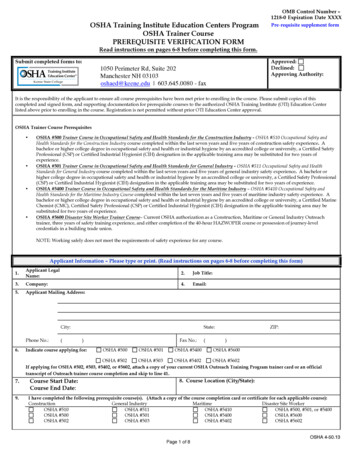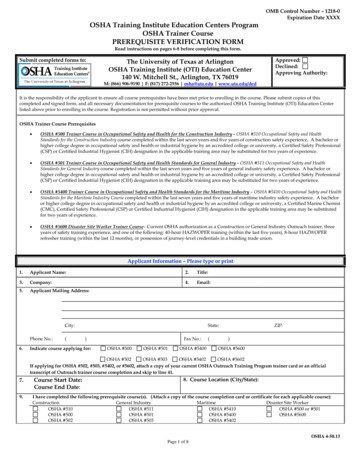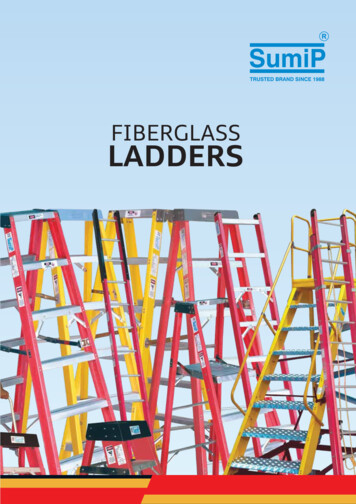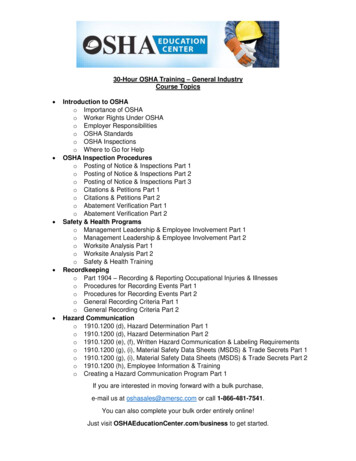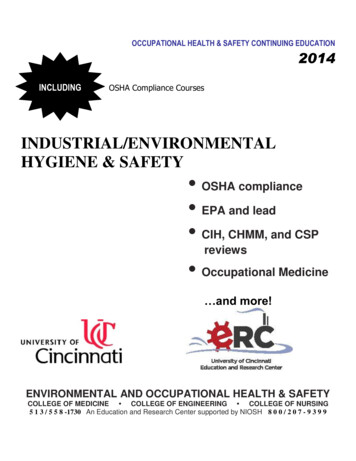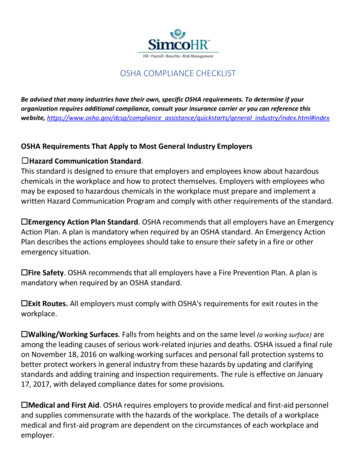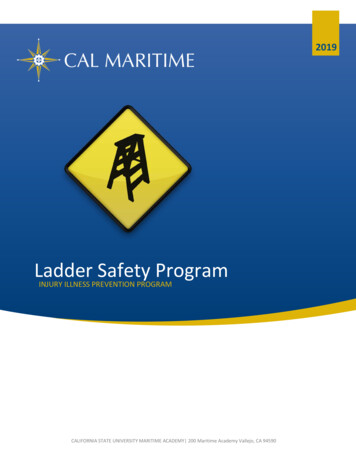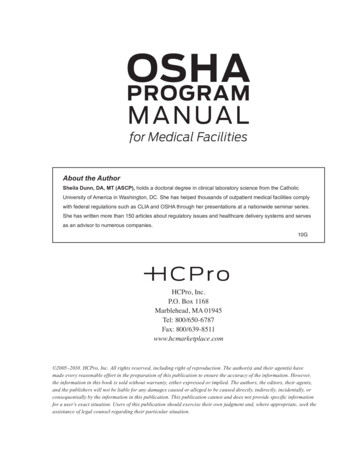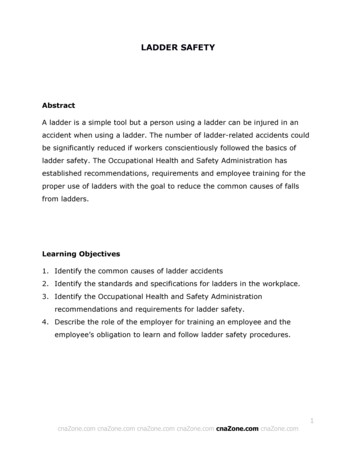
Transcription
LADDER SAFETYAbstractA ladder is a simple tool but a person using a ladder can be injured in anaccident when using a ladder. The number of ladder-related accidents couldbe significantly reduced if workers conscientiously followed the basics ofladder safety. The Occupational Health and Safety Administration hasestablished recommendations, requirements and employee training for theproper use of ladders with the goal to reduce the common causes of fallsfrom ladders.Learning Objectives1. Identify the common causes of ladder accidents2. Identify the standards and specifications for ladders in the workplace.3. Identify the Occupational Health and Safety Administrationrecommendations and requirements for ladder safety.4. Describe the role of the employer for training an employee and theemployee’s obligation to learn and follow ladder safety procedures.cnaZone.com cnaZone.com cnaZone.com cnaZone.com cnaZone.com cnaZone.com1
IntroductionThe ladder is an essential tool that is used every day at work by millions ofpeople. Most workers use ladders safely and without incident but using aladder requires a worker to work at heights. A fall from any height can beserious, and falls from ladders are one of the leading causes of occupationalinjuries and fatalities. Many falls from a ladder are preventable as the greatmajority of them are caused by improper use. The Occupational Health andSafety Administration has established recommendations, requirements andemployee training for the proper use of ladders, as well as standards for themanufacture of ladders. The goal is to reduce the common causes of fallsand injuries from ladder accidents.OSHA and Ladder SafetyA ladder is a simple tool that is frequently used in the workplace. Althoughladders have considerable utility, their use can often lead to accidents thatmay result in injury or even death. The number of ladder-related accidentscould be significantly reduced if workers conscientiously followed the basicsof ladder safety. Knowing how to use ladders properly and safely is of keyimportance in the workplace. The Occupational Health and SafetyAdministration (OSHA) has promulgated rules for training workers in theproper, safe use of ladders.The Occupational Health and Safety Administration is part of the U.S.Department of Labor and establishes standards for workplace safety andrecommendations and requirements for the proper use of equipment. TheOccupational Health and Safety Administration also requires employers totrain employees in the proper and safe use of equipment. Regarding ladders,in 2003 OSHA provided the following statement:cnaZone.com cnaZone.com cnaZone.com cnaZone.com cnaZone.com cnaZone.com2
“Employers must train all employees to recognize hazards related to laddersand stairways, and instruct them to minimize these hazards. Employersmust retrain each employee as necessary to maintain their understandingand knowledge on the safe use and construction of ladders and stairs.Employers must ensure that each employee is trained by a competentperson in the following areas, as applicable: Nature of fall hazards in the work area Correct procedures for erecting, maintaining and disassembling the fallprotection systems to be used Proper construction, use, placement and care in handling of all stairwaysand ladders Maximum intended load-carrying capacities of ladders used.”The OSHA standards and requirements for ladders are outlined in the Codeof Federal Regulations (CFR) 1926.1053, and CFR 1926.1053 can be viewedon the OSHA website, www.OSHA.gov. Examples of what CFR 1926.1053contains are provided below. “Ladders shall be capable of supporting the following loads withoutfailure: Each self-supporting portable ladder: At least four times themaximum intended load, except that each extra-heavy-duty type 1Ametal or plastic ladder shall sustain at least 3.3 times the maximumintended load. The ability of a ladder to sustain the loads indicated in thisparagraph shall be determined by applying or transmitting the requisiteload to the ladder in a downward vertical direction. Ladders built andtested in conformance with the applicable provisions of appendix A of thissubpart will be deemed to meet this requirement.” “Ladder rungs, cleats, and steps shall be parallel, level, and uniformlyspaced when the ladder is in position for use. Rungs, cleats, and steps of3cnaZone.com cnaZone.com cnaZone.com cnaZone.com cnaZone.com cnaZone.com
portable ladders (except as provided below) and fixed ladders (includingindividual-rung/step ladders) shall be spaced not less than 10 inches (25cm) apart, nor more than 14 inches (36 cm) apart, as measured betweencenterlines of the rungs, cleats and steps.”As set forth above, ladders used in the workplace must be manufactured tocertain specifications set forth by OSHA. Employers are required to trainemployees in the proper and safe use of ladders. Additionally, it is theresponsibility of the employee to learn, retain and use this safetyinformation.The Importance of Ladder SafetyFalls are a common cause of work-related and non-occupational injury anddeath, and falls from ladders are particularly serious (Smith, et al, 2006).The Consumer Product Safety Commission (CPSC) estimated that in 2010more than 724,000 people were injured while using a ladder or a stepstool,and Francis (2014) estimated that approximately one person a day will dieas a result of a ladder fall.Approximately 20% of all occupational fall injuries involve a ladder and 81%of fall injuries among construction workers treated in an emergency roominvolve a ladder (Socias, et al, 2014). A 2015 study by Canadian researchersnoted that falls from ladders resulted in serious injuries that required amedian hospital stay of greater than two weeks (Driedger, et al, 2015).Nosaka, et al. (2015) reported a fatality rate from ladder falls of 11% and asignificant number of patients in this study developed neurologicaldisabilities. Falls occurred from step ladders and extension ladders, themedian height of the falls was only 2 meters/6.6 feet, and injuries occurredcnaZone.com cnaZone.com cnaZone.com cnaZone.com cnaZone.com cnaZone.com4
after falls from as low as 1.5 meters/4.8 feet. Con, et al. (2014) reported afatality rate of 3.8% in 340 patients who had a fall from a ladder.A 2004 study by O’Sullivan, et al. (2004) found that falls from a ladderresulted in disability and unemployment for a median duration of six weeks.Bedi, et al. (2008) found that 24% of all people in their study who hadsuffered a ladder fall required hospitalization, and Axelsson and Carter(1995) reported that nearly 40% of workers with ladder-related injuries(93% of which were falls) were absent from work for more than a month,and half of those injured “. experienced continuing, possibly permanentdisability.”A study published by Creighton University (2003), based on statistics fromthe Occupational Safety and Health Administration and the Bureau of LaborStatistics, revealed more than 15 percent of all worker compensation casesare related to ladder accidentsCauses of Ladder FallsLadder falls have many causes, which may include the improper positioningof the ladder causing a lack of stability or the ladder to slip, impropersupport, overextending or overreaching by the person using the ladder,which causes the user to lose balance or the base of the ladder to slip.Additionally, defective ladders, no assistance, poor or no inspection of theladder prior to use, losing balance, slipping or losing footing, impropertraining, and lack of awareness of the risks associated with using a laddermay lead to a ladder fall and serious injury.Understanding ladder falls can be challenging because there are so manypossible causes but all ladder falls can be classified into three categories:cnaZone.com cnaZone.com cnaZone.com cnaZone.com cnaZone.com cnaZone.com5
1) improper use of the ladder, 2) failure of the ladder or of the surface it issupported on, and 3) improper ladder selection (Campbell, et al, 2014).Improper ladder selection frequently happens when a user selects a ladderthat is too short, causing him or her to stand on the top rung or the top ofthe ladder. This is especially likely to occur if the proper ladder is too largeor heavy and a lighter, smaller ladder is used instead for “convenience.”Failure of the ladder can be due to poor maintenance and/or neglecting toinspect the ladder prior to use.Failure of the surface may involve a wet or slippery surface. Improper useinvolves poor set-up, for example, an uneven or slippery surface for theladder base or overreaching (neglecting to keep the body between the rails)instead of climbing down and moving the ladder or failing to place the ladderat the proper angle, causing the ladder to slide from its base (Häkkinen, etal, 1988, and Hsiao, et al, 2008). These slide out failures are one of themost common causes of ladder falls (Chang, et al, 2005) and a literaturereview by Hsiao, et al, identified several factors affecting the likelihood of aladder slide out failure including ladder angle, coefficient of friction, as wellas type, location, and magnitude of the load.Ladder Falls and InjuriesThe height of the fall, the landing surface, and the age of the person(increased age is associated with increased risk of injury) are factors thatdetermine the severity of injury after a fall from a ladder. Injuries that areassociated with ladder falls may include abrasions, contusions, dislocations,fractures, head injuries (brain contusion, intracranial hemorrhage),lacerations, neurologic complications or damage, sprains, traumatic spleeninjury, and spinal injuries. Thoracic, spine, and head injuries or fractures arecnaZone.com cnaZone.com cnaZone.com cnaZone.com cnaZone.com cnaZone.com6
the most likely injuries, but upper and lower extremity injuries or fracturesare common, as well (Con, et al, 2014).Ladder Safety: A Four-part ProcessLadder safety is a four-part process that involves: 1) ladder selection,2) ladder inspection, 3) ladder set-up, and 4) ladder use. Ladder safetybegins with the selection of the proper ladder for the job and includesinspection, setup, proper climbing and standing, and the correct care, useand storage of ladders. In addition to the general safety rules for all laddersthere are special rules for using step ladders and for single and extensionladders. These safety rules are a combination of OSHA regulations andproven common sense procedures. This combination of safe equipment andits safe use can eliminate most ladder accidents.Ladder SelectionThere are four basic types of ladders: 1) step ladders, 2) single ladders,3) extension ladders, and 4) mobile ladders. Step ladders are also calledfolding or fold-out ladders and extension ladders and single ladders are alsocalled leaning ladders. Another category is the articulated ladder, a portable,multi-use ladder with locking hinges that can be used in several differentconfigurations. Ladders can also be categorized as fixed (for example, nonmovable ladders) or portable (for example, self-supporting or non selfsupporting. In the interest of simplicity, the two most commonly usedladders, portable step ladders and portable extension ladders will bediscussed. Figure 1 shows these two types of ladders.Figure 1cnaZone.com cnaZone.com cnaZone.com cnaZone.com cnaZone.com cnaZone.com7
Step LadderExtension LadderA step ladder is a portable, self-supporting ladder, that is intended to beused by one person. Step ladders are typically manufactured in heights of 3to 20 feet; anything less than 3 feet is considered a step stool. Step ladderscan be made from aluminum, fiberglass, or wood. Step ladders arecomprised of the rails, the steps (which are also called cleats or rungs), thetop cap, and the hinges. Many step ladders also have a small extendableplatform that is to be used to hold buckets or tools while the ladder is in use.Fiberglass ladders are often equipped with “shoes,” non-skid caps that areplaced over the bottom of the four rails. Step ladders can be used anywherean extension ladder can be used but there are two important considerationsthat are particular to the use of step ladders. First, a step ladder has foursupporting rails, not two rails as with an extension ladder; the supportingsurface must be chosen carefully with respect how level it is, the friction ofthe surface, and the available space. Step ladders require more spacearound them because of their configuration. Second, step ladders arecnaZone.com cnaZone.com cnaZone.com cnaZone.com cnaZone.com cnaZone.com8
available in heights of up to 20 feet but as with all ladders there is a limit tothe safe working height of a ladder This is discussed below.An extension ladder (and straight ladders) is a portable, non self-supportingladder. Non-self supporting means that the stability of an extension ladderdepends on the top of the ladder being in contact with a surface, forexample, leaning against the side of a building or a wall. Extension ladderscan be made of aluminum, fiberglass or wood. Extension ladders aretypically manufactured to heights of up to 60 feet. An extension ladder iscomprised of the two rails, the steps (also called cleats or rungs), and thebase (the part of the ladder that is set in place on the surface), theextendable part of the ladder, which is called the fly, ropes and pulleys thatare used to extend the fly, and locking mechanisms that keep the fly in placeonce it has been extended.Selecting the proper ladder for a job involves three considerations. The firstconsideration is the environment. If a person is working with electricalequipment or the ladder will be used near a source of electricity analuminum ladder should not be used. The surface and the area on which thebase of the ladder will be resting should be evaluated. The stability of anextension ladder is dependent on the surface its base is resting on and ifthat surface is wet or will not provide sufficient friction for the ladder base,an extension ladder should not be used or the situation should be corrected.A step ladder has four supporting rails, so the supporting surface must bechosen carefully to allow for a safe area around the base of the ladder and toensure the ladder is evenly placed. Stability is also important for a stepladder and a step ladder should only be used if all four rails that form thebase can be placed in a position so that the step ladder is level. Finally, if thecnaZone.com cnaZone.com cnaZone.com cnaZone.com cnaZone.com cnaZone.com9
ladder is used inside or in an enclosed space the size of the ladder must notprevent it from being set up at the proper angle; it should not be too big.The second consideration for ladder selection is the weight the ladder willneed to bear. Ladders are rated for the amount of weight they canaccommodate. This is called the duty rating and there are five categories ofduty ratings: Type IAA, Type IA, Type I, Type II, and Type III.Types IAA through Type I are considered to be industrial use ladders. TypeII is considered to be a medium duty commercial ladder and Type III arelight duty ladders suitable for home use.The duty rating is the maximum weight that the ladder can bear for normaluse, for example, an eight hour work day. In order to determine which typeof a ladder is appropriate for a job, the user’s weight, the weight of theuser’s clothing, and the weight of any equipment or tools that will be used orstored on the ladder should be combined; the total should be less than theduty rating of the ladder. The duty rating of a ladder is usually on a printedlabel that is affixed to one of the rails.cnaZone.com cnaZone.com cnaZone.com cnaZone.com cnaZone.com cnaZone.com10
Type IAA: Special duty ladders. These ladders have a dutyrating of 375 pounds.Type IA: Extra heavy duty ladders. These ladders have aduty rating of 300 ponds.Type I: Heavy duty ladders. These ladders have a dutyrating of 250 pounds.Type II: Medium duty ladders. These ladders have a dutyrating of 225 pounds.Type III: Light duty ladders. These ladders have a dutyrating of 200 pounds.The duty rating is the amount of weight load that a ladder can withstandduring normal expected use. Ladders can hold more weight than their dutyrating. For example, OSHA requires that a self-supporting, portable ladder(except for Type IA metal or plastic ladders) be able to withstand four timesthe maximum intended load. However, the duty rating of a ladder shouldnever be exceeded.The next consideration in ladder selection is the size of the ladder. Selectingthe right size of ladder requires the user to know at what height the work is;cnaZone.com cnaZone.com cnaZone.com cnaZone.com cnaZone.com cnaZone.com11
for example the user may be painting a wall and the surface that needspaint starts at 15 feet and ends at 20 feet. The user will also need to knowthe maximum working height at which the ladder can be used and theproper set-up angle of the straight or extension ladder. All of these factors,the ladder size, the height at which the work will be done the maximumworking height of the ladder, and the proper set-up angle areinterdependent.As mentioned previously, ladders are typically 3-60 feet long. The higheststanding point should be 2-3 feet down from the top of the ladder; thisinformation should be on a label on one of the rails of the ladder. Themaximum working height is the height plus how far the user will need toreach to do the job.Most people work best at shoulder level. The average shoulder level isapproximately five feet above where someone would stand on a ladder, theuser should stand at least two to three feet below the top of the ladder, sothe maximum working height feet is approximately the height of the ladderminus two to three feet.The ladder is 20 feet from the base to the top. The user is standing threefeet below the top, shoulder level is about five feet, so the maximumeffective working height is 22 feet. The set-up angle is crucial becauseslipping of the ladder base, also referred to as a slide-out failure, is one ofthe most common causes of ladders accidents. The American NationalStandards Institute (ANSI) recommends a set-up angle of 75.5 . This can bereasonably estimated by placing the base of the ladder at distance from thesupporting surface that is equal to one-fourth of the height of the ladder; thebase of 20 foot ladder would be placed 5 feet from the supporting surface.cnaZone.com cnaZone.com cnaZone.com cnaZone.com cnaZone.com cnaZone.com12
Set-up angle is obviously an important consideration when choosing laddersize; it will be discussed in the Ladder Set-Up section later on.Ladder InspectionThe ladder user should always check a ladder before using it. The usershould inspect wood ladders for cracks and splits in the wood. All laddersshould be checked to see that cleats, steps, or rungs are tight, secure, andclean. The user should be sure that all hardware and fittings are properlyand securely attached.The ladder user should always test movable parts of the ladder to see thatthey operate without binding or without too much free play. Metal andfiberglass ladders should be inspected for bends and breaks. Also, the ladderuser should be sure that metal steps and rungs are grooved or roughened toprevent slipping. Ladder rungs, cleats, or steps must be parallel, level, anduniformly spaced when the ladder is in position for use. Rungs must bespaced between 10 and 14 inches apart and rungs must be so shaped thatthe user’s foot cannot slide off, and must be skid-resistant. Step laddersmust have a metal spreader or locking device to hold the front and backsections in an open position when in use. (See Figure 2 below)Figure 2cnaZone.com cnaZone.com cnaZone.com cnaZone.com cnaZone.com cnaZone.com13
The ladder user should never use a damaged ladder. It should be marked asdefective or tagged as ”Do not use” and the user should report it to asupervisor so that it may be removed from the work area. The OSHA CFR1926.1053 states that ladders shall be inspected by a competent person forvisible defects on a periodic basis and after any occurrence that could affectsafe use of a ladder. Portable ladders with structural defects, such as, butnot limited to, broken or missing rungs, cleats, or steps, broken or split rails,corroded components, or other faulty or defective components, shall eitherbe immediately marked in a manner that readily identifies them asdefective, or be tagged with "Do Not Use" or similar language, and shall bewithdrawn from service until repaired.Fixed ladders with structural defects, such as, but not limited to, broken ormissing rungs, cleats, or steps, broken or split rails, or corrodedcomponents, shall be withdrawn from service until repaired. Therequirement to withdraw a defective ladder from service is satisfied if theladder is either immediately tagged with "Do Not Use" or similar language,or is marked in a manner that readily identifies it as defective.Ladder Set-UpcnaZone.com cnaZone.com cnaZone.com cnaZone.com cnaZone.com cnaZone.com14
The ladder use should place the ladder base firmly and evenly on the groundor floor. Before climbing the user should make sure the ladder is set up atthe proper angle and is secure. The ladder user should never try and extendthe working height of a ladder by placing it on boxes, barrels, bricks, blocksor other unstable bases. The ladders should be allowed to lean sideways.The user should brace the base of the ladder with stakes or place stoutboards against the feet if there is any danger of slipping.A ladder should never be set up in a high wind, especially a lightweightmetal or fiberglass type. The ladder user should wait until the air is calmenough to insure safety. A ladder should never be set up in front of a doorunless the door is locked or a guard is posted. Ladders should not be usedon ice or snow unless absolutely necessary. If they must be used on ice orsnow, a spike or spur-type safety shoes should be used on the ladder feetand the user should be sure they are gripping properly before climbing.Safety shoes should be used if there is any possibility of slipping.Top support for a ladder is as important as good footing. The top should restevenly against a flat, firm surface. If a ladder is to be leaned against roofgutters, the strength and stability of the gutters should first be tested. Whena ladder is used for access to an upper landing surface, it must extend threerungs, or at least three feet above the landing surface.A ladder used for access to an upper landing surface should be securedagainst sideways movement at the top or held by another worker wheneverit is being used. The ladder user should extend an extension ladder onlyfrom the ground. The height needed should be determined, and the ladderuser should extend and lock the fly section securely in place then set it upagainst the wall.cnaZone.com cnaZone.com cnaZone.com cnaZone.com cnaZone.com cnaZone.com15
The ladder user should always check for ladder stability and support beforeclimbing. If possible, the base of a long ladder should be secured to theground and the top should be tied to the upper landing surface.The set-up angle is crucial because slipping of the ladder base, also referredto as a slide-out failure, is one of the most common causes of ladderaccidents. The ANSI recommends a set-up angle of 75.5 . This can bereasonably estimated by placing the base of the ladder at distance from thesupporting surface that is equal to one-fourth of the height of the ladder; thebase of a 20 foot ladder would be placed 5 feet from the supporting surface.Campbell, et al. (2014) evaluated six set-up methods:Basic:The basics of ladder use involves evaluation of the proper position of theladder simply by visual estimation, or “eyeballing.” The failure rate of thismethod has been reported to be 9.8%, and the following statistics indicaterelative failure rates based upon ladder position and user activity. 75 degree: The user places the ladder at what is perceived to be 75 .The failure rate of this method was 15.2%. 4:1: This method was previously explained, and was found to be theleast accurate with a failure rate of 18.8%. Stand-reach: The user places the toes at the base of the ladder, extendsthe arms and sees if the pals touch the rungs. The failure rate of themethod was 3.3%. L-sticker: Some ladders have a sticker on a rail in the shape of an L. Theuser aligns the upright part of the L with the surface the ladder issupported by. The failure rate of this method was 3.3%.cnaZone.com cnaZone.com cnaZone.com cnaZone.com cnaZone.com cnaZone.com16
Bubble level: The bubble level was found to be the most accurate, with afailure rate of 1.1%Other considerations for ladder setup include the following: 1) When using aladder where there is traffic, the user should erect warning signs orbarricades to guide traffic away from the foot of the ladder. If this is notpossible, someone should be assigned to hold and guard the bottom of theladder. 2) There needs to be clearance between the rungs and steps and thesupporting surface. OSHA CFR 1926.1053 requires a “ . minimumperpendicular clearance between fixed ladder rungs, cleats, and steps, andany obstruction behind the ladder shall be 7 inches (18 cm), except in thecase of an elevator pit ladder for which a minimum perpendicular clearanceof 4 1/2 inches (11 cm) is required.”There needs to be clearance between the rungs and steps and from anyobstruction on the climbing side of the ladder. OSHA CFR 1926.1053requires a “ . minimum perpendicular clearance between the center line offixed ladder rungs, cleats, and steps, and any obstruction on the climbingside of the ladder shall be 30 inches (76 cm), except as provided inparagraph (a)(15) of this section. When unavoidable obstructions areencountered, the minimum perpendicular clearance between the centerlineof fixed ladder rungs, cleats, and steps, and the obstruction on the climbingside of the ladder may be reduced to 24 inches (61 cm), provided that adeflection device is installed to guide employees around the obstruction.”The OSHA guidelines state that ladders placed in any location where theycan be displaced by workplace activities or traffic, such as in passageways,doorways, or driveways, shall be secured to prevent accidentaldisplacement, or a barricade shall be used to keep the activities or trafficcnaZone.com cnaZone.com cnaZone.com cnaZone.com cnaZone.com cnaZone.com17
away from the ladder (OSHA CFR 1926.1053). Notably, the followingguidelines should be followed. The area around the top and bottom of ladders shall be kept clear (OSHACFR 1926.1053). The top of a non-self-supporting ladder shall be placed with the two railssupported equally unless it is equipped with a single support attachment(OSHA CFR 1926.1053). Ladders shall not be used on slippery surfaces unless secured or providedwith slip-resistant feet to prevent accidental displacement. Slip-resistantfeet shall not be used as a substitute for care in placing, lashing, orholding a ladder that is used upon slippery surfaces including, but notlimited to, flat metal or concrete surfaces that are constructed so theycannot be prevented from becoming slippery (OSHA CFR1926.1053).OSHA CFR 1926.1053 can be viewed on the OSHA website, www.OSHA.gov.Another good source of information about ladder safety is the AmericanLadder Institute Ladder Safety page, which can be viewed athttp://laddersafetytraining.org/.Basics of Extension Ladder Set-UpThe basic requirements of extension ladder set-up are as follows:Step 1. Lay the ladder on the ground with the base resting against thebottom of the wall and the top pointing away from the wall.Step 2. Starting at the top of the ladder, lift the end over the head and walkunder the ladder to the wall, moving the hands from rung to rung whilesetting up the ladder.cnaZone.com cnaZone.com cnaZone.com cnaZone.com cnaZone.com cnaZone.com18
Step 3. When the ladder is vertical, and the top touches the wall, pull outthe base so that the distance away from the wall is about one-fourth of theheight to the point of support or use another method for estimating theproper set-up angle.Step 4. Reverse this process to take down the ladder. The user will bewalking backwards and, therefore, will need to check for obstacles in his/herpath before starting. Also, the user will need to be careful to lower theladder slowly so that it is kept under control and to prevent the ladder fromfalling on top of the user.Ladder users should remember that the sections of an extension laddershould overlap enough to retain the strength of the ladder using thefollowing table:Length of LadderUp to 36 feetOver 36 to 48 feetOver 48 to 50 feetRequired Overlap3 feet4 feet5 feetLadder UseThe ladder user should not try to move a ladder while on it by rocking orpushing it away from a supporting wall. Ladders should never be used whenunder the influence of alcohol, when in ill health, or if taking medicationsthat can affect the user’s balance and coordination or that can make theuser dizzy. If the ladder user gets sick, dizzy or panicky while on a ladder,he/she should not try to climb down in a hurry. Instead, the ladder usercnaZone.com cnaZone.com cnaZone.com cnaZone.com cnaZone.com cnaZone.com19
should drape the arms around the rungs, rest the head against the ladderuntil feeling better, and then climb down slowly and carefully.Tools or materials should not be left on top of ladders. If they fall, the useror another worker can be injured. The ladder user should never push or pullanything sideways while on a ladder. This puts a side load on the ladder andcan cause it to tip out from under the user. Only one person at a time on aladder should be allowed unless the ladder is specifically designed for twopeople. A ladder should never be used as a horizontal platform, plank,scaffold or material hoist.The lad
Maximum intended load-carrying capacities of ladders used." The OSHA standards and requirements for ladders are outlined in the Code of Federal Regulations (CFR) 1926.1053, and CFR 1926.1053 can be viewed . portable ladders (except as provided below) and fixed ladders (including individual-rung/step ladders) shall be spaced not less than 10 .
